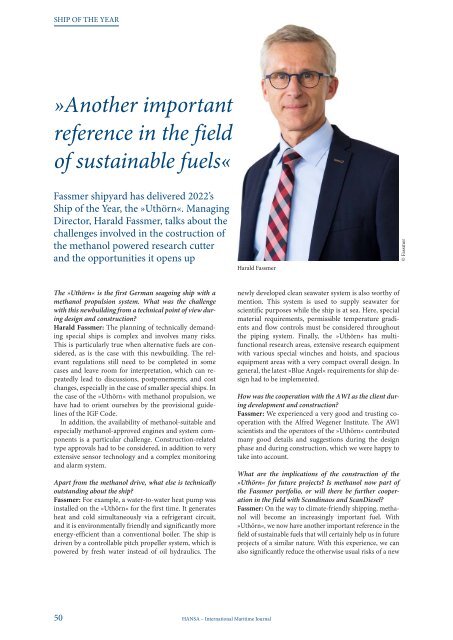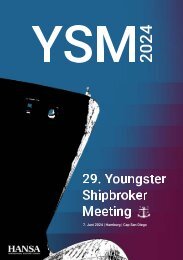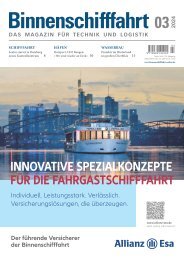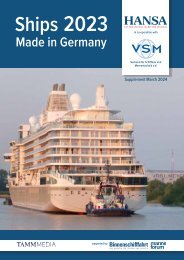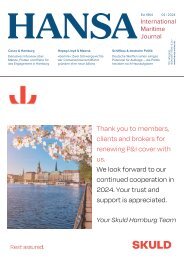HANSA VSM Special - Ships made in Germany 2022
Die englischsprachige Sonderpublikation „Ships made in Germany“ erscheint in offizieller Kooperation mit dem Verband für Schiffbau- und Meerestechnik (VSM). Die Publikation dient der internationalen Darstellung der deutschen Werftindustrie! Es werden herausragende Neubauprojekte sowie der aktuelle Auftragsbestand auf deutschen Werften beschrieben. Die Redaktion der HANSA kürt das „Ship of the Year“.
Die englischsprachige Sonderpublikation „Ships made in Germany“ erscheint in offizieller Kooperation mit dem Verband für Schiffbau- und Meerestechnik (VSM). Die Publikation dient der internationalen Darstellung der deutschen Werftindustrie! Es werden herausragende Neubauprojekte sowie der aktuelle Auftragsbestand auf deutschen Werften beschrieben. Die Redaktion der HANSA kürt das „Ship of the Year“.
You also want an ePaper? Increase the reach of your titles
YUMPU automatically turns print PDFs into web optimized ePapers that Google loves.
SHIP OF THE YEAR<br />
»Another important<br />
reference <strong>in</strong> the field<br />
of susta<strong>in</strong>able fuels«<br />
Fassmer shipyard has delivered <strong>2022</strong>’s<br />
Ship of the Year, the »Uthörn«. Manag<strong>in</strong>g<br />
Director, Harald Fassmer, talks about the<br />
challenges <strong>in</strong>volved <strong>in</strong> the costruction of<br />
the methanol powered research cutter<br />
and the opportunities it opens up<br />
Harald Fassmer<br />
© Fassmer<br />
The »Uthörn« is the first German seago<strong>in</strong>g ship with a<br />
methanol propulsion system. What was the challenge<br />
with this newbuild<strong>in</strong>g from a technical po<strong>in</strong>t of view dur<strong>in</strong>g<br />
design and construction?<br />
Harald Fassmer: The plann<strong>in</strong>g of technically demand<strong>in</strong>g<br />
special ships is complex and <strong>in</strong>volves many risks.<br />
This is particularly true when alternative fuels are considered,<br />
as is the case with this newbuild<strong>in</strong>g. The relevant<br />
regulations still need to be completed <strong>in</strong> some<br />
cases and leave room for <strong>in</strong>terpretation, which can repeatedly<br />
lead to discussions, postponements, and cost<br />
changes, especially <strong>in</strong> the case of smaller special ships. In<br />
the case of the »Uthörn« with methanol propulsion, we<br />
have had to orient ourselves by the provisional guidel<strong>in</strong>es<br />
of the IGF Code.<br />
In addition, the availability of methanol-suitable and<br />
especially methanol-approved eng<strong>in</strong>es and system components<br />
is a particular challenge. Construction-related<br />
type approvals had to be considered, <strong>in</strong> addition to very<br />
extensive sensor technology and a complex monitor<strong>in</strong>g<br />
and alarm system.<br />
Apart from the methanol drive, what else is technically<br />
outstand<strong>in</strong>g about the ship?<br />
Fassmer: For example, a water-to-water heat pump was<br />
<strong>in</strong>stalled on the »Uthörn« for the first time. It generates<br />
heat and cold simultaneously via a refrigerant circuit,<br />
and it is environmentally friendly and significantly more<br />
energy-efficient than a conventional boiler. The ship is<br />
driven by a controllable pitch propeller system, which is<br />
powered by fresh water <strong>in</strong>stead of oil hydraulics. The<br />
newly developed clean seawater system is also worthy of<br />
mention. This system is used to supply seawater for<br />
scientific purposes while the ship is at sea. Here, special<br />
material requirements, permissible temperature gradients<br />
and flow controls must be considered throughout<br />
the pip<strong>in</strong>g system. F<strong>in</strong>ally, the »Uthörn« has multifunctional<br />
research areas, extensive research equipment<br />
with various special w<strong>in</strong>ches and hoists, and spacious<br />
equipment areas with a very compact overall design. In<br />
general, the latest »Blue Angel« requirements for ship design<br />
had to be implemented.<br />
How was the cooperation with the AWI as the client dur<strong>in</strong>g<br />
development and construction?<br />
Fassmer: We experienced a very good and trust<strong>in</strong>g cooperation<br />
with the Alfred Wegener Institute. The AWI<br />
scientists and the operators of the »Uthörn« contributed<br />
many good details and suggestions dur<strong>in</strong>g the design<br />
phase and dur<strong>in</strong>g construction, which we were happy to<br />
take <strong>in</strong>to account.<br />
What are the implications of the construction of the<br />
»Uthörn« for future projects? Is methanol now part of<br />
the Fassmer portfolio, or will there be further cooperation<br />
<strong>in</strong> the field with Scand<strong>in</strong>aos and ScanDiesel?<br />
Fassmer: On the way to climate-friendly shipp<strong>in</strong>g, methanol<br />
will become an <strong>in</strong>creas<strong>in</strong>gly important fuel. With<br />
»Uthörn«, we now have another important reference <strong>in</strong> the<br />
field of susta<strong>in</strong>able fuels that will certa<strong>in</strong>ly help us <strong>in</strong> future<br />
projects of a similar nature. With this experience, we can<br />
also significantly reduce the otherwise usual risks of a new<br />
50 <strong>HANSA</strong> – International Maritime Journal


